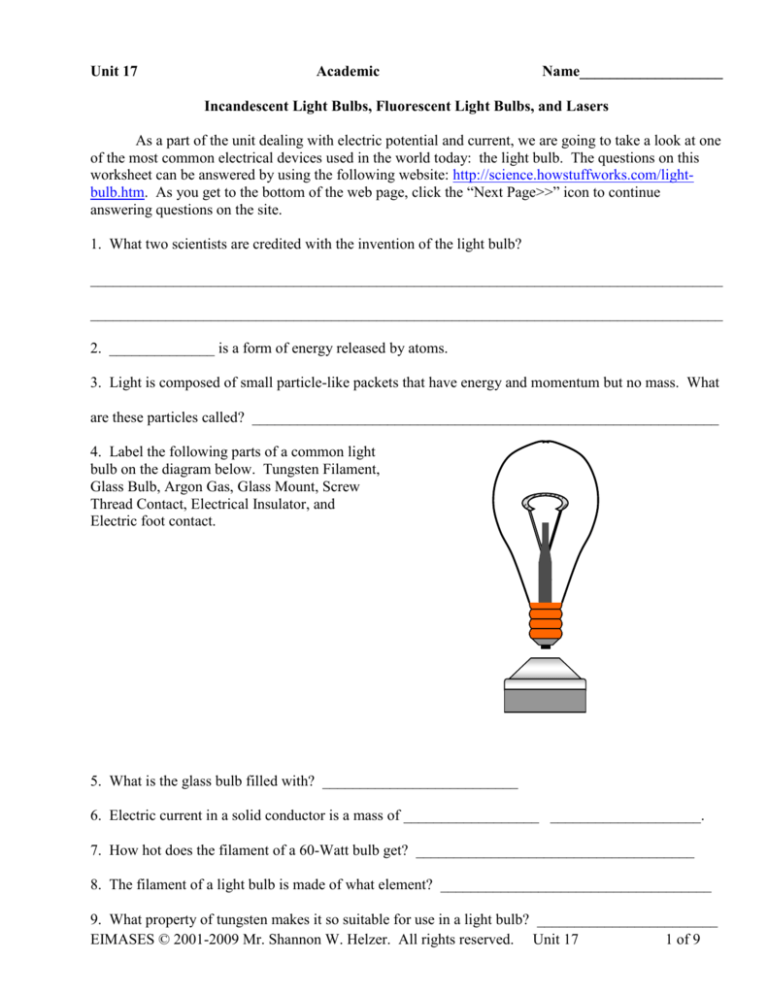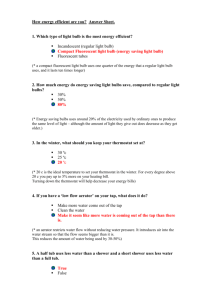
Unit 17
Academic
Name___________________
Incandescent Light Bulbs, Fluorescent Light Bulbs, and Lasers
As a part of the unit dealing with electric potential and current, we are going to take a look at one
of the most common electrical devices used in the world today: the light bulb. The questions on this
worksheet can be answered by using the following website: http://science.howstuffworks.com/lightbulb.htm. As you get to the bottom of the web page, click the “Next Page>>” icon to continue
answering questions on the site.
1. What two scientists are credited with the invention of the light bulb?
____________________________________________________________________________________
____________________________________________________________________________________
2. ______________ is a form of energy released by atoms.
3. Light is composed of small particle-like packets that have energy and momentum but no mass. What
are these particles called? ______________________________________________________________
4. Label the following parts of a common light
bulb on the diagram below. Tungsten Filament,
Glass Bulb, Argon Gas, Glass Mount, Screw
Thread Contact, Electrical Insulator, and
Electric foot contact.
5. What is the glass bulb filled with? __________________________
6. Electric current in a solid conductor is a mass of __________________ ____________________.
7. How hot does the filament of a 60-Watt bulb get? _____________________________________
8. The filament of a light bulb is made of what element? ____________________________________
9. What property of tungsten makes it so suitable for use in a light bulb? ________________________
EIMASES © 2001-2009 Mr. Shannon W. Helzer. All rights reserved. Unit 17
1 of 9
10. In problem 5 you learned that a bulb is filled with Argon. Argon is an inert gas. Why are inert
gases used inside a light bulb?
____________________________________________________________________________________
____________________________________________________________________________________
Now go to the following website to answer questions about fluorescent lights.
http://science.howstuffworks.com/fluorescent-lamp.htm
11. Atoms release light photons when their ____________________ are excited to higher energy levels
and then immediately falls back to a lower energy level.
12. The amount of energy released by an electron determines the _________________ of light.
13. The wavelength of light directly correlates to the _____________________ of light.
14. Label the following parts of the cutaway view of a fluorescent bulb shown below: glass tube,
mercury blob, contact pins, electrode, and the inert gas.
15. Number the steps in the process of lighting a fluorescent light from 1 to 5.
_______ Mercury changed from a liquid to a gas.
_______ Electrons return to lower energy states releasing light photons.
_______ Electric switch moved from “off” to “on” position.
_______ Electrons and mercury gas collide bumping the electrons to higher energy levels.
_______ Due to a large voltage difference, electrons migrate from one end of the tube to the other.
16. Fluorescent light emits photons in the non-visible ultraviolet range. How is this light converted to
visible light?
____________________________________________________________________________________
____________________________________________________________________________________
EIMASES © 2001-2009 Mr. Shannon W. Helzer. All rights reserved.
Unit 17
2 of 9
17. What is the difference in the way electrons move through solid conductors and in the way they
move through a gas conductor?
____________________________________________________________________________________
____________________________________________________________________________________
18. What are the electrodes found in the fluorescent bulb? ____________________________________
19. How are the necessary free electrons introduced into the glass bulb that produces the light?
____________________________________________________________________________________
____________________________________________________________________________________
20. Under the section entitled “Light Right Away,” be sure to turn the switch from the “off” to the “On”
position and watch the light light up.
Now go to the following website to answer questions about lasers.
http://science.howstuffworks.com/laser.htm
21. What is meant by states of excitation? ________________________________________________
____________________________________________________________________________________
22. When an atom is not excited, it is found in its ________________________________ energy level.
23. What happens to the electrons in an atom of we strike it with energy, heat, or light? ____________
____________________________________________________________________________________
24. An electron moved to a higher energy level eventually returns to its lower energy level. When it
does, it emits a __________________________ which is a particle of light.
25. The word “laser” stands for L______________ A__________________ by S__________________
E____________________ of R________________________.
26. The term “wavelength” corresponds to a ___________________________.
27. What are the three properties of laser light that distinguishes it from other light forms? Define these
properties.
_______________________ - ___________________________________________________________
_______________________ - ___________________________________________________________
_______________________ - ___________________________________________________________
EIMASES © 2001-2009 Mr. Shannon W. Helzer. All rights reserved.
Unit 17
3 of 9
28. In order for the properties above to occur, there must be ____________________ ______________.
29. What is the purpose of the mirrors in a laser? ___________________________________________
____________________________________________________________________________________
30. Label the following components of the laser below: Flash tube, ruby crystal, mirrored surface,
partially silvered mirror, transformer, laser beam, and laser body.
31. In your own words, explain how a basic laser like the one above works.
____________________________________________________________________________________
____________________________________________________________________________________
____________________________________________________________________________________
____________________________________________________________________________________
____________________________________________________________________________________
____________________________________________________________________________________
____________________________________________________________________________________
____________________________________________________________________________________
____________________________________________________________________________________
____________________________________________________________________________________
____________________________________________________________________________________
EIMASES © 2001-2009 Mr. Shannon W. Helzer. All rights reserved.
Unit 17
4 of 9
Light
Note: Answers to the questions below may be found in Chapter 27 on page 404 of the conceptual
physics textbooks located in the back of the room. You must read this chapter in order to understand the
material presented in this unit.
32. According to Albert Einstein’s ________________ ________________ theory, light exist as
particles known as photons.
33. What is the value of the speed of light? ________________________________________________
34. The distance light travels in one year is known as a ____________________ __________________.
35. A light wave is partly __________________ and partly _____________________, As a result, it is
known as an ________________________________ __________________.
36. The lowest frequency of light we see appears to be ___________________ in color.
37. The highest frequency of light we see appears to be ___________________ in color.
38. Fill in the blanks below corresponding to the electromagnetic spectrum.
_____________, Microwaves, _____________, Visible Light, ______________, X-ray, ____________
39. Light is energy carried in a electromagnetic wave that is generated by _______________
______________ charges.
40. ___________________ materials are materials that allow light to pass through it. Two examples of
such materials are ___________________________ and __________________________.
41. Of the wavelengths of the
electromagnetic spectrum, only a
few can pass through glass.
Label the waves to the right as
either Ultraviolet, Visible Light,
or Infrared.
EIMASES © 2001-2009 Mr. Shannon W. Helzer. All rights reserved.
Unit 17
5 of 9
42. Glass allows visible light to pass through it; therefore we say it is transparent to visible light.
However, glass does not allow infrared radiation and ultraviolet radiation to pass through; therefore, we
say that glass is _______________________ to infrared radiation and ultraviolet radiation.
43. What happens to opaque materials that are struck by non-transparent radiation types. How do they
feel when you touch them? _____________________________________________________________
44. When light cannot reach part of a body, a _____________________ is formed.
45. A complete shadow or darkest part of a shadow is known as a _________________ and a partial
shadow or lighter part of a shadow is known as a _________________________.
46. A shadow of a bowling pin is drawn to the right. Draw a line two the two parts of the
shadow (as answered in problem 14) and label these parts.
47. Which of the shadows to the left, A or B, is most likely the shadow of a
bowling pin placed very close to a wall? Explain your answer.
_________________________________________________________________
A
B
_________________________________________________________________
48. Which of the shadows to the left, A or B, is most likely the shadow of a bowling pin placed very far
from a wall? Explain your answer.
____________________________________________________________________________________
____________________________________________________________________________________
49. ________________________ demonstrates that light waves travel as ____________________
waves and not as longitudinal waves.
50. Why isn’t the light emitted from the sun or a common light bulb polarized?
____________________________________________________________________________________
____________________________________________________________________________________
EIMASES © 2001-2009 Mr. Shannon W. Helzer. All rights reserved.
Unit 17
6 of 9
51. Which wave shown to the below
passing through a polarizer is vertically
polarized? Explain your answer.
________________________________
________________________________
________________________________
________________________________
52. Which type of light wave, vertically or horizontally polarized, is capable of
making it through the series of polarizers shown to the left. Explain your
answer.
________________________________________________________________
________________________________________________________________
________________________________________________________________
54. Are you right eyed or left eyed? Test yourself as described in the text. _______________________
55. In the figure above, which man is the tallest? _______________________________________
EIMASES © 2001-2009 Mr. Shannon W. Helzer. All rights reserved.
Unit 17
7 of 9
Color
Note: Answers to the questions below may be found in Chapter 28 on page 421 of the conceptual
physics textbooks located in the back of the room. You must read this chapter in order to understand the
material presented in this unit.
56. What colors appear in and in what order do the colors appear in the color or visible light spectrum?
a. _____________________________
b. __________________________
c. _____________________________
d. __________________________
e. _____________________________
f. __________________________
g. _____________________________
h. __________________________
57. When the seven colors above are combined, they form what “color” of light?
__________________
58. There are two “colors” that that are not really colors. What are they? Explain why they are not
colors.
____________________________ - Why? ________________________________________________
____________________________ - Why? ________________________________________________
59. Consider the two cubes above. If blue light was shined on each cube, then what color would the
cubes appear to be? Explain your answer.
White Cube:__________________ - Why? ________________________________________________
____________________________________________________________________________________
Black Cube:__________________ - Why? ________________________________________________
____________________________________________________________________________________
60. The __________________ of a transparent object depends on the color of the light it transmits.
61. The material in the glass that selectively absorbs colored light is known as ____________________.
EIMASES © 2001-2009 Mr. Shannon W. Helzer. All rights reserved.
Unit 17
8 of 9
Blue
62. What color would the eye in the figure to the right see?
Explain your answer.
_________________________________________________
RED
Red
_______________________ - ________________________
Green
_________________________________________________
63. What are the additive primary colors?
____________________________________________________________________________________
64. What are the complimentary colors? What colors must be mixed in order to get these colors?
___________________ = ____________________ + ________________________
___________________ = ____________________ + ________________________
___________________ = ____________________ + ________________________
Do the flag activity on page 429 of your text. Answer the questions below.
65. What color does the yellow background appear to be when you stare at a white area?
____________________________________________________________________________________
66. What color does the blacks stars and stripes appear to be when you stare at a white area?
____________________________________________________________________________________
67. What color does the blue stripes appear to be when you stare at a white area?
_______________________________________________
68. Do you see a similar effect when you repeat this exercise with the black & white flag?
_______________________________________________
EIMASES © 2001-2009 Mr. Shannon W. Helzer. All rights reserved.
Unit 17
9 of 9








